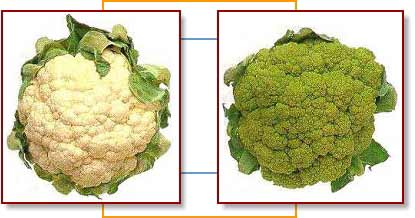 |
 |

 Make Cauliflower Part of Your 5 A Day
Plan Make Cauliflower Part of Your 5 A Day
Plan
- Raw florets make a crunchy, nutritious appetizer with low-fat
dressing or dip.
- Add fresh or leftover cauliflower to soups or stews.
- Use chopped florets in place of meatballs as an addition to
your favorite pasta sauce for a delightful vegetarian pasta dish.
- Cauliflower can also add a zest to your favorite tossed salad.
- Cauliflower can be substituted for broccoli in many dishes.
- Stir cooked cauliflower into mashed potatoes to enhance their
texture (see Twice-Baked Potatoes recipe below).
|
Recipes
Cauliflower with Paprika-Garlic Sauce
Makes 4 servings.
Ingredients
4 cups small cauliflower florets
2 gloves garlic, minced
1 tsp olive oil
2 Tbsp apple juice
1 Tbsp snipped fresh parsley
1 Tbsp red wine vinegar
1½ tsp paprika
1/8 tsp salt
In a large saucepan with steamer rack, steam cauliflower over boiling
water covered for about 8 minutes or until crisp-tender. Meanwhile, using
a small saucepan prepare sauce. First cook garlic in hot oil for 30
seconds. Remove from heat; stir in apple juice, parsley, vinegar, paprika,
and salt. Cook sauce until heated. Transfer cauliflower to a serving dish.
Pour sauce over the hot cauliflower. Toss to coat.
Nutritional analysis per serving: Calories 44, Total Fat 1g, Saturated Fat
0g, Carbohydrates 8g, Protein 2g, Cholesterol 0mg, Fiber 3g, Sodium 104mg, Carbohydrates
58%, Protein 17%, Fat: 25%.
Potato Vegetable Salad with Yogurt - An Official 5 A Day Recipe
Makes 6 Servings.
Ingredients
2 pounds red potatoes
2 cups broccoli florets
2 cups cauliflower florets
2 medium carrots, peeled
1 medium cucumber
¾ cup sliced radishes
½ cup sliced scallions
1 cup plain low-fat yogurt
3 Tbsp Dijon mustard
½ tsp salt
½ tsp freshly ground pepper
Steam potatoes until they are tender. While potatoes are cooling, steam
broccoli and cauliflower until slightly cooked, about 4 minutes. Set
broccoli and cauliflower aside to cool. Cut carrots into thin slivers.
Slice cucumber. Cut potatoes into chunks. Gently stir all vegetables
together in a large mixing bowl. In another bowl, whisk together yogurt,
mustard, salt and pepper. Pour dressing over vegetables and stir carefully
until dressing coats everything evenly. Refrigerate 1 hour before serving.
Nutritional analysis per serving: Calories 230, Total Fat 1g, Saturated Fat
0g, Carbohydrates 47g, Protein 11g, Cholesterol 2mg, Fiber 6g, Sodium
338mg, Carbohydrates 74%, Protein 18%, Fat 8%.
Twice-Baked Potatoes
 Makes
4 entree-size or 8 side-dish servings. Makes
4 entree-size or 8 side-dish servings.
Modified
from "Evelyn Tribole's Book "Stealth Health", p. 28-29,
Viking 1998.
Ingredients
4 medium potatoes, washed
1 ½ lbs cauliflower, washed green leaves removed
5 Tbsp nonfat milk, divided
½ tsp salt
¼ tsp black pepper
1 cup (4 ounces) finely shredded reduced-fat sharp Cheddar cheese
Paprika
Preheat the oven to 350°F. Using a fork, puncture the potatoes. Bake
for 40 to 50 minutes until tender. Meanwhile, cut cauliflower into about
eight pieces and steam until very tender. Transfer the cauliflower to a
food processor or blender (in two batches if necessary). Add 2 tablespoons
of the milk, salt, and pepper. Puree until smooth; the mixture will
resemble mashed potatoes and make about 1 cup puree. Set aside.
Cut potatoes in half lengthwise. Scoop out the pulp and place into a
large mixing bowl, leaving thin shells. Using an electric mixture on
lowest speed, beat the potato pulp and the remaining milk until blended.
Add the puréed cauliflower mixture and beat until well mixed (do not over
beat). Stir in half of the shredded cheese.
Divide mixture among the potato shells. Top with remaining cheese and
sprinkle with paprika. Return to oven and bake until the cheese melts,
about 5 minutes.
Nutritional analysis per serving: Calories 349, Total Fat 5g, Saturated Fat
2g, Carbohydrates 50g, Protein 26g, Cholesterol 21mg, Fiber 9g, Sodium
555mg, Carbohydrates 57%, Protein 13%, Fat 30%.
*This document is available in Portable Document
Format (PDF). You will need Acrobat
Reader (a free application) to view and print this document.
|
|

